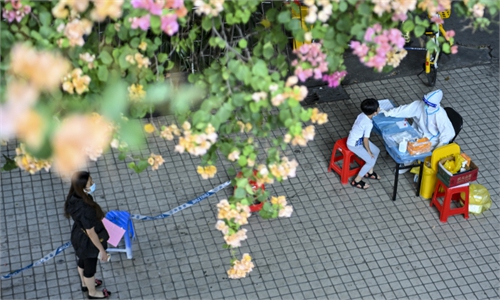Guangzhou sees limited impact for trade as the city deals with toughest battle against COVID19

A medical worker takes a swab sample from a resident for nucleic acid test at a community in Liwan district of Guangzhou, South China's Guangdong Province. Photo: Xinhua
Guangzhou, the capital city of South China's Guangdong Province, has seen a limited impact on logistic and trade so far thanks to the local government's launch of dynamic epidemic control measures to bring down the possible impact of the outbreak and quick reining of the virus to stop it from further spreading, industry experts told the Global Times on Sunday.
Guangzhou, a major manufacturing and transportation hub, is facing the most complicated and severe epidemic situation in three years, as the deputy director of the city's health commission Zhang Yi told a press conference for the epidemic control over the weekend.
A total of around 5,000 cases have been reported since the new outbreak took place in October 22. Moreover, the new local infections amounted to 1,325 cases in a single day on Saturday, reaching a record high since the outbreak.
A Guangzhou-based trader told the Global Times on Sunday, on condition of anonymity, that while the outbreak has lasted for two weeks and concerns for its possible impact are lingering, the actual disruption to the local trade business has been limited so far.
"We are still able to deliver our goods in and out of the region by following the epidemic control requirements such as the regular nucleic acid tests for cargo truck drivers," the person said, adding that both sea and air transportation are accessible.
But the trader noted that his company's warehouse is not based in some high-risk area, a possible reason for its operations having remained unaffected.
As of 10 am on Sunday, Guangzhou still presents 42 high-risk areas and 64 medium-risk areas, according to media reports.
While there are medium or high-risks areas in Baiyun district, a concentration of warehousing and logistics, and Panyu district, a factory settlement, the transportation to and from Guangzhou port, a major trade hub in the region, has not been substantively impacted, Zhong Zhechao, founder of One Shipping, an international logistics service consulting company, told the Global Times on Sunday.
So far, the Guangzhou port is running undisrupted with both in and out access to the port staying normal, which allows international trade to remain unaffected despite the outbreak, he said.
Meanwhile, in a bid to minimize the impact while also curbing the epidemic, the areas that are under static management have been mostly limited to compounds and streets, instead of applying district or citywide lockdowns.
The dynamic management of the local government has partially contributed to bringing down the impact of the epidemic to a minimum level, Zhong said.
Despite the pressure from the epidemic, Guangzhou port's trade business shows a steady growth. As of the end of October, the port had operated 35 sea-rail combined transports, with the number of containers delivered by the transports exceeding 200,000, a year-on-year increase of 54.5 percent, according to the port.
While the impact from the outbreak is so far limited to the regional logistic and trade in general terms, Zhong said that some potential impact still deserves attention, especially as the epidemic situation enters a critical stage, with some new cases reported at community level.
Global Times

